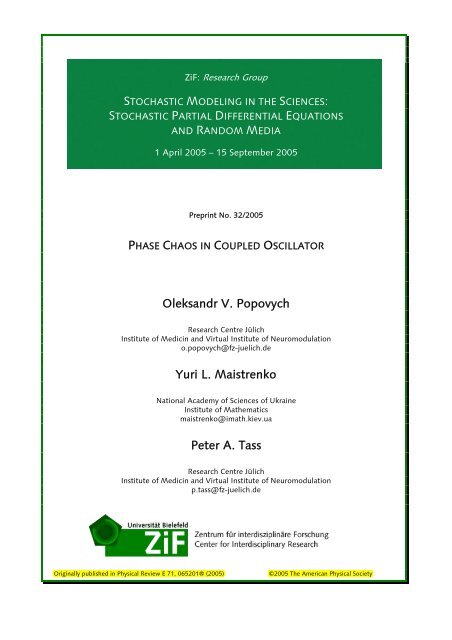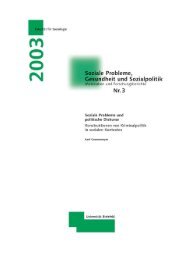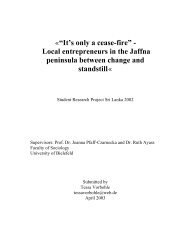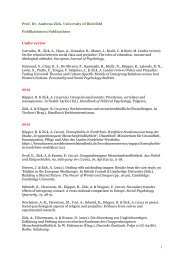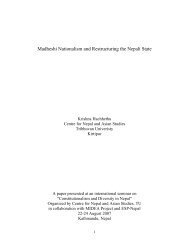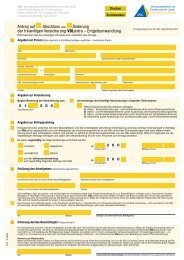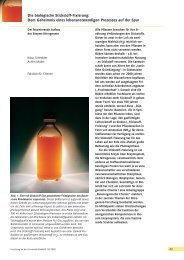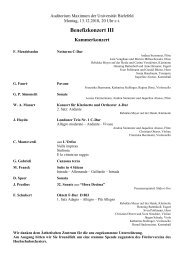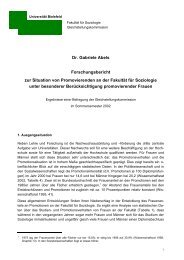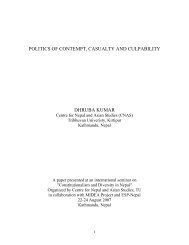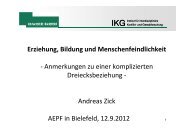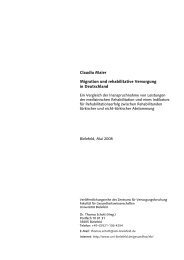Phase Chaos in Coupled Oscillators
Phase Chaos in Coupled Oscillators
Phase Chaos in Coupled Oscillators
Create successful ePaper yourself
Turn your PDF publications into a flip-book with our unique Google optimized e-Paper software.
ZiF: Research Group<br />
STOCHASTIC MODELING IN THE SCIENCES:<br />
STOCHASTIC PARTIAL DIFFERENTIAL EQUATIONS<br />
AND RANDOM MEDIA<br />
1 April 2005 – 15 September 2005<br />
Prepr<strong>in</strong>t No. 32/2005<br />
PHASE CHAOS IN COUPLED OSCILLATOR<br />
Oleksandr V. Popovych<br />
Research Centre Jülich<br />
Institute of Medic<strong>in</strong> and Virtual Institute of Neuromodulation<br />
o.popovych@fz-juelich.de<br />
Yuri L. Maistrenko<br />
National Academy of Sciences of Ukra<strong>in</strong>e<br />
Institute of Mathematics<br />
maistrenko@imath.kiev.ua<br />
Peter A. Tass<br />
Research Centre Jülich<br />
Institute of Medic<strong>in</strong> and Virtual Institute of Neuromodulation<br />
p.tass@fz-juelich.de<br />
Orig<strong>in</strong>ally published <strong>in</strong> Physical Review E 71, 065201® (2005) ©2005 The American Physical Society
<strong>Phase</strong> chaos <strong>in</strong> coupled oscillators<br />
Oleksandr V. Popovych, 1 Yuri L. Maistrenko, 1,2,3 and Peter A. Tass 1,4<br />
1 Institute of Medic<strong>in</strong>e and Virtual Institute of Neuromodulation, Research Centre Jülich, 52425 Jülich, Germany<br />
2 Central Institute for Electronics, Research Center Jülich, 52425 Jülich, Germany<br />
3 Institute of Mathematics, National Academy of Sciences of Ukra<strong>in</strong>e, 01601 Kyiv, Ukra<strong>in</strong>e<br />
4 Department of Stereotaxic and Functional Neurosurgery, University Hospital, 50924 Cologne, Germany<br />
�Received 1 December 2004; published 6 June 2005�<br />
A complex high-dimensional chaotic behavior, phase chaos, is found <strong>in</strong> the f<strong>in</strong>ite-dimensional Kuramoto<br />
model of coupled phase oscillators. This type of chaos is characterized by half of the spectrum of Lyapunov<br />
exponents be<strong>in</strong>g positive and the Lyapunov dimension equal<strong>in</strong>g almost the total system dimension. Intrigu<strong>in</strong>gly,<br />
the strongest phase chaos occurs for <strong>in</strong>termediate-size ensembles. <strong>Phase</strong> chaos is a common property of<br />
networks of oscillators of very different natures, such as phase oscillators, limit-cycle oscillators, and chaotic<br />
oscillators, e.g., Rössler systems.<br />
DOI: 10.1103/PhysRevE.71.065201 PACS number�s�: 05.45.Xt, 05.45.Jn<br />
The Kuramoto model of coupled phase oscillators �1�,<br />
�˙ i = �i + K<br />
N� N<br />
s<strong>in</strong>��j − �i�, i =1, ...,N, �1�<br />
j=1<br />
is one of the most popular and often cited networks <strong>in</strong> modern<br />
nonl<strong>in</strong>ear science and application �2�. It reflects generic<br />
properties of ensembles of globally coupled limit-cycles oscillators<br />
of very different nature. Its applications cover a<br />
wide range of self-organiz<strong>in</strong>g systems <strong>in</strong> the natural sciences<br />
and medic<strong>in</strong>e, e.g., Josephson-junction arrays �3�, semiconductor<br />
lasers arrays �4�, coupled chemical reactions �5�, and<br />
cardiac pacemaker cells �6�. Several neurological diseases,<br />
such as Park<strong>in</strong>son’s disease, are characterized by a synchronization<br />
of ensembles of oscillatory neurons <strong>in</strong> particular<br />
bra<strong>in</strong> areas, where the normal fir<strong>in</strong>g is supposed to be uncorrelated<br />
�7�. The development of desynchroniz<strong>in</strong>g deep bra<strong>in</strong><br />
stimulation for the therapy of such diseases �8�, together with<br />
the successful cl<strong>in</strong>ical tests of this therapeutic approach �9�,<br />
have led to an <strong>in</strong>creas<strong>in</strong>g <strong>in</strong>terest <strong>in</strong> nonsynchronized states<br />
of networks of oscillators. The design of optimal techniques<br />
for selective disruption of synchronization requires sufficient<br />
knowledge of relevant features of the variety of possible desynchronized<br />
states.<br />
The Kuramoto model �1� exhibits <strong>in</strong>coherent behavior at<br />
small and <strong>in</strong>termediate values of the coupl<strong>in</strong>g coefficient K,<br />
and a spontaneous transition to collective synchronization as<br />
K exceeds a certa<strong>in</strong> threshold Kc. In spite of numerous studies<br />
dur<strong>in</strong>g the last two decades, be<strong>in</strong>g ma<strong>in</strong>ly based on a<br />
statistical approach <strong>in</strong> the thermodynamic limit N→�, the<br />
f<strong>in</strong>ite-dimensional character of model �1� is still far from<br />
be<strong>in</strong>g understood �2,10�. In particular, unsolved and challeng<strong>in</strong>g<br />
problems refer to global stability and convergence.<br />
In this paper, we present a complex high-dimensional chaotic<br />
regime <strong>in</strong> the Kuramoto model �1�, as a typical phenomenon<br />
of phase chaos �11� <strong>in</strong> coupled oscillator systems. We<br />
f<strong>in</strong>d that phase chaos <strong>in</strong> coupled oscillators extends over<br />
small and <strong>in</strong>termediate coupl<strong>in</strong>g strength up to the synchronization<br />
transition. This type of chaos arises as soon as<br />
N=4 or more oscillators <strong>in</strong>teract. With <strong>in</strong>creas<strong>in</strong>g system size<br />
PHYSICAL REVIEW E 71, 065201�R� �2005�<br />
RAPID COMMUNICATIONS<br />
N, its complexity develops and phase chaos becomes high<br />
dimensional: The number of positive Lyapunov exponents<br />
�LE� is found to equal �N−2�/2 �N even� or �N−3�/2 �N<br />
odd�, and the Lyapunov dimension reaches almost the total<br />
system dimension N. We also show that the <strong>in</strong>tensity of<br />
phase chaos <strong>in</strong> coupled oscillators, as given by the maximal<br />
LE, decays quadratically with coupl<strong>in</strong>g strength K and <strong>in</strong>verse<br />
proportionally to ensemble size N. Intrigu<strong>in</strong>gly, the<br />
“most chaotic” phase chaos emerges for <strong>in</strong>termediate-size<br />
ensembles.<br />
<strong>Phase</strong> chaos <strong>in</strong> coupled oscillators is a robust phenomenon.<br />
We found phase chaos <strong>in</strong> the Kuramoto model �1� for<br />
both uniform and Gaussian distributions of the natural frequencies<br />
� i. This type of chaos is generated by <strong>in</strong>tr<strong>in</strong>sic<br />
phase <strong>in</strong>teractions, and is also typical for other ensembles of<br />
oscillators of very different nature. We demonstrate that<br />
phase chaos emerges <strong>in</strong> networks of limit-cycle oscillators<br />
and coupled chaotic Rössler systems. In the case of coupled<br />
chaotic oscillators, phase chaos manifests itself <strong>in</strong> the appearance<br />
of additional chaotic components, where additional<br />
positive LEs �with respect to those of <strong>in</strong>dividual oscillators�<br />
emerge.<br />
First, we consider the simplest coupled oscillator system,<br />
where phase chaos occurs: N=4 <strong>in</strong> Eq. �1�. By <strong>in</strong>troduc<strong>in</strong>g<br />
the phase difference variables � i=� i+1−� i, i=1,2,3, the dimension<br />
of the Kuramoto model is reduced by one. The system<br />
dynamics is then governed by a three-dimensional torus<br />
flow �. In Fig. 1�a� three LEs of the flow � are plotted<br />
versus the coupl<strong>in</strong>g strength K. The maximal LE � 1 is positive<br />
for values of K between K 0�0.94 and K 1�1.22, which<br />
implies the existence of a chaotic attractor A �see Fig. 1�c��.<br />
Before the chaotic attractor A is born, i.e., for K�K 0, the<br />
system dynamics is mostly quasiperiodic �solid torus curve<br />
<strong>in</strong> Fig. 1�b��. The transition to chaos at K 0 ensues <strong>in</strong> accordance<br />
with the torus destruction scenario �16�. With <strong>in</strong>creas<strong>in</strong>g<br />
K, first, the dynamics fits <strong>in</strong>to a resonance �w<strong>in</strong>dow for<br />
K��K sn,K 0�, see <strong>in</strong>set <strong>in</strong> Fig. 1�a��: A stable periodic orbit P<br />
�crosses <strong>in</strong> Fig. 1�b�� and a saddle Q of the resonance 9: 10<br />
appear <strong>in</strong> a saddle-node bifurcation at K=K sn. Then, at the<br />
exit from the resonance, the chaotic attractor A is born �black<br />
1539-3755/2005/71�6�/065201�4�/$23.00 065201-1<br />
©2005 The American Physical Society


